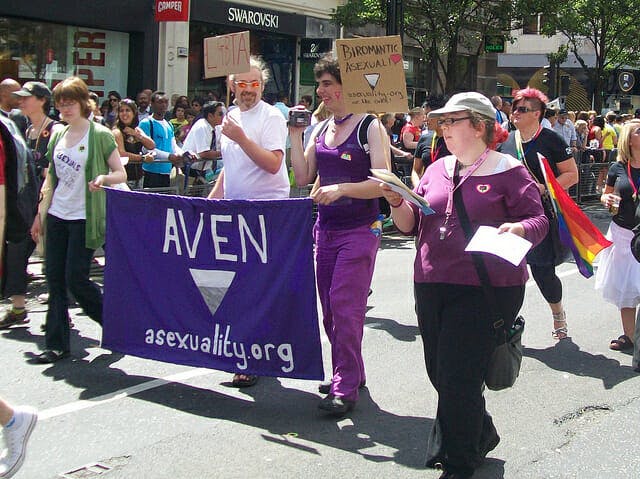When it comes to queer sexualities, most Americans are familiar with homosexuality and bisexuality. But there’s more to the LGBTQ umbrella than just experiencing sexual attraction to the same gender. Asexuality is gradually growing in visibility, and that means that the definition of asexual has developed its own broad spectrum. More and more, activists are shedding light onto the hardships that asexual people go through.
But most Americans still know very little about asexuality and how asexuals experience the world around them. What’s it like being asexual? Here’s everything you need to know.
What does asexual mean?
Asexuality is a “sexual orientation characterized by a persistent lack of sexual attraction toward any gender,” according to the website What is Asexuality? Asexual people neither “experience sexual attraction” nor can they choose to; they are simply born without sexual desires. Conversely, people who do experience sexuality are referred to as either sexual or allosexual people, AVENWiki reports.
It’s important to point out that asexuality isn’t a lifestyle decision. Rather, asexuals simply do not feel sexual attraction. People who are celibate, dealing with sexual repression, or actively choose not to embrace their sexual desires aren’t necessarily asexual. Rather, asexuals simply do not have the desire, need, or feeling to have sex with others.

READ MORE:
- 5 dating apps for queer women without any of the bulls**t
- The best dating apps for every type of relationship
- Breaking down the difference between gender identity and sex
- Trans and nonbinary people explain what gender dysphoria feels like
What about romantic relationships or asexual dating?
Asexual people may not experience sexual attraction, but that doesn’t necessarily mean asexuals can’t have sex or date other people. Asexuals can still feel romantically attached to others. Rather, the sexual component behind romantic attraction simply isn’t a part of their identity.
Instead, asexuals find themselves on the asexual spectrum, which breaks down romantic and sexual attraction by showing the various sexual identities people can have. In short, there are three main categories on the spectrum: asexuals, gray-A people and demisexuals, and sexual people, as explained by HuffPost.
https://www.youtube.com/watch?v=v_avcbuZDQE
From there, the spectrum branches off into various romantic experiences that can exist in conjunction with all three categories. Here is each listed with definitions:
- Heteroromantic–Romantic attraction to one specific gender, different from one’s own (e.g., men who love women)
- Homoromantic–Romantic attraction to one’s own gender (e.g., women who love women)
- Biromantic–Romantic attraction to one’s own gender as well as others’ (e.g., women who love men and women)
- Panromantic–Romantic attraction to others, regardless of gender (e.g., men who can fall in love with any gender)
- Aromantic–Not experiencing romantic attraction
Of course, while there are plenty of asexuals that do not feel a need to fall in love with other people, there are also many asexuals that experience romantic affection for others without sexual desires. That means asexual dating actually looks similar to other romantic relationships. It’s just that sex may be negotiated within the relationship if one partner experiences sexual attraction and the other does not.
What are demisexuals and gray-A people?

AVENWiki describes a demisexual as someone “who does not experience sexual attraction unless they form a strong emotional connection with someone.”
Unlike asexuals, demisexuals experience sexuality. But it’s important for them to bond with other people in order to build a sexual relationship. Of course, this doesn’t necessarily mean demisexuals must be in a romantic relationship to have sex with others. Demisexuals can still hook up with their friends. But whether it’s dating or a one-night stand, demisexuals have to have a close relationship with another person in order to have sex.
Gray-A people, meanwhile, have varying relationships with sexuality. These range from people who “do not normally experience sexual attraction, but do experience it sometimes” to those who “enjoy and desire sex, but only under very limited and specific circumstances,” AVENWiki points out. Individuals who identify as gray-A do so because their sexual identity doesn’t neatly fit into sexual nor asexual experiences. Instead, their sexuality is largely based on context, and more often than not is relatively limited.
READ MORE:
- Everything you have never understood about being nonbinary
- The dirty, complex, empowering history of the word ‘queer’
- What it means to be transgender
- The pride and pitfalls in LGBTQ labels
How can you tell if you’re asexual?

Asexuality can be difficult to figure out, in part because sexuality is such a complicated human experience. But asexuality isn’t a binary, and there are plenty of ways to define your sexuality on the asexual spectrum.
The site What is Asexuality? hosts a list of questions that commonly pertain to asexual experiences. For instance, many asexuals don’t understand why sex is so appealing or why others find people “hot” and “sexy.” Other asexuals don’t particularly comprehend sex scenes in movies and books, instead wondering why characters feel a sudden and intense physical desire for one another. Asexuality Archive also hosts a series breaking down asexual experiences, with the intent of helping readers figure out if they are asexual.
Asexuality can be difficult to figure out, and for some, it can take months or years to understand their sexual identity. But above all, asexuality is defined by the person who is asexual. That means every asexual has a different relationship with their sexuality, and no two asexuals experience the world the same way.
Editor’s note: This article is regularly updated for relevance.


